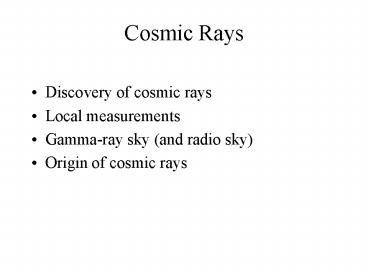Cosmic Rays - PowerPoint PPT Presentation
1 / 20
Title:
Cosmic Rays
Description:
Need to multiply by cross sections and convolve along lines of sight. ... As for gamma-rays, need to convolve the electron CR spectrum with the Galactic ... – PowerPoint PPT presentation
Number of Views:36
Avg rating:3.0/5.0
Title: Cosmic Rays
1
Cosmic Rays
- Discovery of cosmic rays
- Local measurements
- Gamma-ray sky (and radio sky)
- Origin of cosmic rays
2
Discovery of Cosmic Rays
Problem that electroscopes would always lose
their charge. In 1912 Hess flew electroscopes
in balloons (up to 17,500 feet) and showed that
the rate of loss increased with altitude, thus
showing that the particles causing the loss of
charge were produced external to the Earth. He
called them cosmic radiation.
3
Cosmic rays
Isotropic CR 2 electrons, 98 hadrons.
Hadrons 89 H, 10 He, 1 heavier
elements. Energy density CR 1
eV/cm3 Starlight 0.3 eV/cm3 B-field 0.2
eV/cm3 CMB 0.3 eV/cm3 Knee at 3?1015 eV
g 2.7
g 3.1
g 2.7
4
Cosmic ray spectrum
5
Confinement
Milky Way B 3 ?G. Lamour radius rg p/qB,
for protons, rg 1012 cm (E/GeV). Scale height
of Galactic disk is 5?1020 cm, thus, protons
with energies up to about 1017 eV can be
confined. At low energies, heliosphere affects
trajectories.
6
Greisen-Zatsepin-Kuzmin Cutoff
- Cosmic rays will interact with cosmic microwave
background p? ? p? - Only occurs when proton has enough energy to
produce pion, E 5?1019 eV - Detection of particles above this energy requires
local sources (or new physics).
7
Cosmic ray abundances
Rare elements and radioactive isotopes are over
abundant due to spallation.
8
Spallation
Cosmic rays collide with nuclei in ISM, changing
the composition. For example
- Observed CR composition depends on
- Initial CR composition
- CR path length/life time
- CR energy
- Measurement of CR composition, including
isotopes, allows one to constrain these
quantities. - Find path length traversed by CR by comparing
abundant elements to those produced by spallation
(i.e. B vs C, Cr vs Fe). Path length 50 kg m-2
(with some energy dependence).
9
Cosmic Ray Life Time
10Be is about 10 of all Be produced by
spallation, has lifetime of 3.9?106 years.
Cosmic rays are confined in the Galaxy for about
107 years before escaping.
10
Leaky Box
Leaky box model CRs diffuse inside a
containment volume (volume of Milky Way disk) and
are reflected at boundaries with some probability
of escape. Typical path length 50 kg m-2 and
typical lifetime 107 years. Confinement is
assumed to be done by Galactic magnetic
field. Note that highest energy CR are not
confined by magnetic fields of Milky
Way. Implies roughly uniform distribution of
cosmic rays through out the Galaxy.
11
Photon production by cosmic rays
- Pion production
- p N ? ?0 X
- ?0 has total charge 0, baryon number 0
- so ?0 can decay via ?0 ? ??
- Neutron pion mass 135 MeV,
- Decay produces two photons of 70 MeV
- Electron bremsstrahlung cosmic ray electrons
on ISM - Inverse Compton cosmic ray electrons on star
light
12
Gamma-Ray Sky
13
Gamma-ray spectrum
Modeling of spatial distribution and spectrum
requires 3-d models of cosmic ray, matter, and
star light distributions in Milky Way. Need to
multiply by cross sections and convolve along
lines of sight. Suggestion that CR spectrum is
harder towards Galactic center.
14
Photon production by cosmic rays
- Electron cosmic rays produce radio emission via
synchrotron radiation in the Galactic magnetic
field - Radiated spectrum peaks at a frequency
As for gamma-rays, need to convolve the electron
CR spectrum with the Galactic magnetic field
distribution along each line of sight.
15
Milky Way at 408 MHz
16
Total Power in Cosmic Rays
- Volume of Galactic disk V ?R2d.
- For R 15 kpc, d 200 pc, find V 4?1066 cm3.
- Power in cosmic rays L V?/?.
- energy density 1 eV/cm3
- lifetime of CR 107 years.
- Find L 1041 erg/s in high energy particles.
17
Power Source Supernovae?
- Supernovae
- E Mechanical energy 1051 erg
- R rate 1/100 years
- ? efficiency for conversion of mechanical
energy into relativistic particles 10 (?) - LSN ?ER 2?1041 erg/s
- Need mechanism for acceleration, need to know if
acceleration is really 10 efficient.
18
Power Source Massive Star Winds?
- O and B star winds
- Mechanical power 1037 erg/s, integrated over 3
million year life time gives total energy 1031
erg - Winds have speeds of 2000-4000 km/s
- Expect multiple stars within OB associations
- OB associations are bright in gamma-rays
19
Cosmic Ray Map
20
Power Source X-Ray Binaries?
- Jets from X-ray binaries known to contain
relativistic particles - Only SS 433 is know to accelerate hadrons, and
that jet is not ultrarelativistic - Integrated output of X-ray binaries appears to be
too low to power full CR population, but may
contribute a few percent































